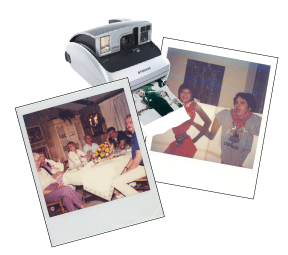
|
Volume XVII, Issue 2 - January 8 - January 14, 2009
|
|
Columns |
Bay Reflections
Out with the Old
Polaroid’s eponymous camera is one more snapshot from our past
by Margaret Tearman
“Due to marketplace conditions, Polaroid has discontinued almost all of its instant analog hardware products. Polaroid has also made the difficult decision to cease manufacturing of instant film products in 2008.”
With those dire words posted on its web site, Polaroid bows to the altar of digital. Its iconic instant camera has become a collectable, a museum piece, a snapshot of our past.
 The click and whirr is a part of my life’s soundtrack. In my mind’s eye, I can picture the developing photographs spread over kitchen counters and dining room tables. We’d wait and watch in awe as the empty black morphed into ghostly shadows and then into recognizable images. It was magic.
The click and whirr is a part of my life’s soundtrack. In my mind’s eye, I can picture the developing photographs spread over kitchen counters and dining room tables. We’d wait and watch in awe as the empty black morphed into ghostly shadows and then into recognizable images. It was magic.
Polaroids were my generation’s version of Facebook or YouTube. In college and those few carefree years immediately after, nary a party was held without an instant camera to record the hilarity — and the evidence. I remember more than a few mornings-after wondering why oh why did I let my picture be taken doing that. There would have been little to worry about if film had to be taken in for processing, as the party would be long forgotten and revelers scattered by the time the pictures came back.
Polaroid was not the only manufacturer of instant cameras, but it was the best known and the first to hit the commercial market. Developed by Polaroid Corporation’s founder Edwin Land, the Land Camera was first sold in 1948. The early instant cameras used roll film until the familiar pack film was introduced in 1963. The early film self-developed, but it sometimes took several minutes, especially in cold weather. I remember holding the photo inside a jacket or under my arm to keep it warm enough to develop. In 1972, Polaroid introduced its 600 series. You no longer had to keep the developing pictures warm, but you did have to catch them as they were ejected from the camera. It was part of the fun.
When I began my career in television and video production, the instant camera went from party cop to tool of the job. One of my responsibilities was to make sure there was a Polaroid instant camera — and plenty of film — on hand. Photos were taken of the set and actors to ensure continuity: where the actors were standing, what they wore and how their hair was parted, where the vase of flowers sat on the table, the curtains parted or books sat on shelves.
The director would sometimes ask for a photo before the real filming began as a preview of the set design and lighting. A pack of instant film was a lot cheaper than videotape and the image could be viewed in an instant.
I’ve been away from that line of work for a while now, but I wonder if digital is as effective. Sure, pictures can be viewed immediately, but how? I can’t imagine the producer, director and camera operator all crowding around the camera’s tiny LCD screen, a hand shielding it from glare that makes the picture impossible to see. And say a prayer for the sorry soul who accidentally deletes photos from the camera. One has to work a bit harder to trash a stack of photos.
Digital may be the technology of today, but for convenience sake — and for the fun of it — I’ll take the instant camera.
Evidently, I’m not alone in my preference. Fans of the instant camera have set up a web site www.savepolaroid.com to persuade Polaroid to at least continue making the film. The site includes Ways to Take Action with a letter-writing campaign and petition.
It remains to be seen whether this grass-roots campaign will sway Polaroid. It’s more likely than not the instant camera — and the signature white bordered pictures it produced — will fade away, becoming yet another memory of days past.